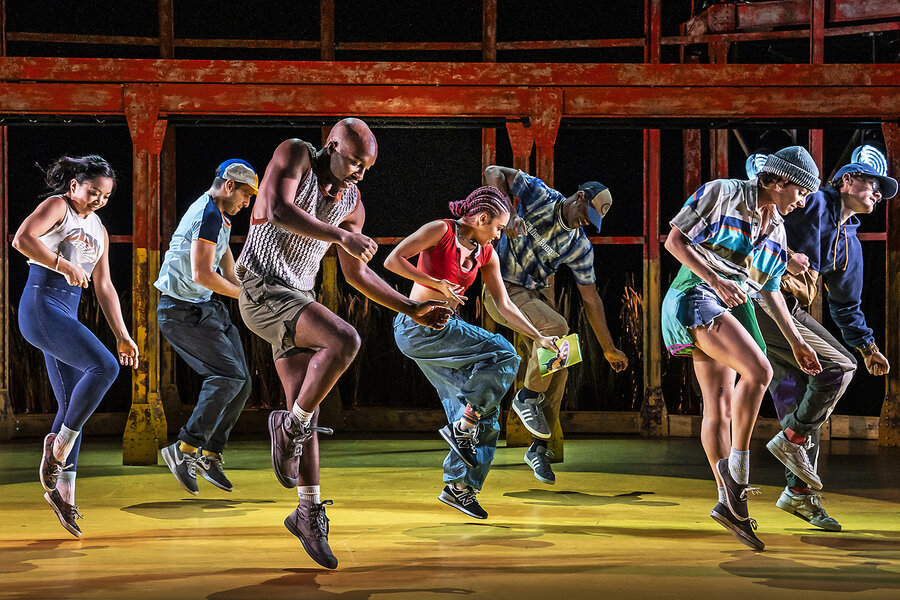A cult classic album gains new life, and new meaning, onstage
Loading...
| New York
It’s hard to describe Sufjan Stevens’ beloved 2005 album “Illinois” in a sentence. Even a paragraph – the next one included – wouldn’t do the 74-minute project justice.
Thematically, the Prairie State’s history is but a starting point. In addition to touching on locales like Peoria and Decatur, figures like Frank Lloyd Wright and Carl Sandburg, and esoterica like the 1893 Columbian Exposition’s White City, the album’s tracks meditate on love, loss, liberation, Christianity, mystery, and self-discovery. Listeners will hear shades of rock, folk, jazz, electronica, and classical minimalism. Mr. Stevens performs on 20 instruments, ranging from oboe, saxophone, and recorder to banjo, organ, and accordion.
Why We Wrote This
A story focused onHow do you adapt a beloved indie album for the stage that includes everything from Frank Lloyd Wright to zombies, the oboe to the accordion? A composer who worked on the new “Illinoise” talks about the assignment of a lifetime.
So it’s fitting that the new stage adaptation, “Illinoise” – which opened March 7 at New York’s Park Avenue Armory after a February run in Chicago – does just as much to step outside the lines. Director and choreographer Justin Peck puts expressive, allegorical movement at the center. It is not quite a musical, not quite a ballet, not quite a concert – but an experience all its own.
Composer and pianist Timo Andres spoke to the Monitor about adapting “Illinois” for the stage: “The opportunity to take one of my favorite albums and arrange it for live performance in an ideal way? That is thrilling, and it’s probably the only time that it will ever happen in my life.”
It’s hard to describe Sufjan Stevens’ beloved 2005 album “Illinois” in a sentence. Even a paragraph – the next one included – wouldn’t do the 74-minute project justice.
Thematically, the Prairie State’s history is but a starting point. In addition to touching on locales like Peoria and Decatur, figures like Frank Lloyd Wright and Carl Sandburg, and esoterica like the 1893 Columbian Exposition’s White City, the album’s tracks meditate on love, loss, liberation, Christianity, mystery, and self-discovery. Listeners will hear shades of rock, folk, jazz, electronica, and classical minimalism. Mr. Stevens performs on 20 instruments, ranging from oboe, saxophone, and recorder to banjo, organ, and accordion.
So it’s fitting that the new stage adaptation, “Illinoise” – which opened March 7 at New York’s Park Avenue Armory after a February run in Chicago – does just as much to step outside the lines. Director and choreographer Justin Peck puts expressive, allegorical movement at the center, while a dialogueless narrative he crafted with playwright Jackie Sibblies Drury leaves audiences considering the power of story and the trials of human connection. It is not quite a musical, not quite a ballet, not quite a concert – but an experience all its own.
Why We Wrote This
A story focused onHow do you adapt a beloved indie album for the stage that includes everything from Frank Lloyd Wright to zombies, the oboe to the accordion? A composer who worked on the new “Illinoise” talks about the assignment of a lifetime.
There is, of course, a lot of “Illinois” (the album) to be enjoyed courtesy of the 11-piece band and three vocalists – but in a thoughtful reconfiguration that draws energy from its live performance. Composer and pianist Timo Andres, who arranged and orchestrated the score, also incorporates some expanded moments of instrumental ambience and soloistic flair.
Mr. Andres spoke to the Monitor about adapting “Illinois” for the stage. The interview has been edited for length and clarity.
Do you remember the first time you heard “Illinois”?
I remember it very well, actually. I was in my dorm room – I think it was my junior year of college.
I’d certainly heard Sufjan’s name. I hadn’t heard his music yet. It made a real impression because it didn’t sound like anything else I had heard. The sound, the actual timbres of the album, were very different from any other kind of pop music that I was listening to at the time. And it seemed to me to be very much in dialogue with a lot of the contemporary chamber music that my friends and I were listening to and writing. This idea that contemporary classical music and contemporary pop music could be in conversation with each other was a very new thing.
Did you feel pressure to capture any of the magic of the original recordings?
Hugely. That was very much part of my goal – how can I take this beautifully unwieldy thing and make it, in any sense, practicable? And I love the original and I love the sound of it, the chamber music aspect of it and the variety of instrumental colors that are on the album.
I would never want to get rid of those things. Obviously, the sound of my arrangements does depart from the originals in certain ways, by necessity. But I think, for those people who know the album, they’ll find that more of it is familiar than not.
How did you go about finding an instrumentation that could approximate what was happening on the album?
It was really little by little. The first step was, I just listened through the album and every time I heard an instrument, I wrote it down. I have a long list of all the tracks on the album with all the instruments that I heard in there. ... It would have been a real orchestra.
So then it became a question of, how can we start to pare this down? How can we create some efficiencies here? Can we hire anyone who can play multiple instruments? What instruments can our singers play? ... So for example, instead of multiple trumpets just for a couple of moments. I have a trumpet and a French horn. And French horn is an instrument that actually does not appear on the original album. But that was something I added because I knew, from an orchestration standpoint, French horn is a Swiss Army knife. It can do so much and it can blend with so much. It can glue things together that wouldn’t otherwise mesh together.
Do you think the vocalists in “Illinoise” are adding a new essence to Sufjan’s songwriting?
That was something that Justin [Peck] and I intended from the start. We didn’t want to try and find singers who would just sound like Sufjan, who would try to imitate anything, but rather people who would understand the world that these Sufjan songs exist in and then be able to give them their own spin.
So yes, the three vocalists absolutely add layers of meaning, and they’re also, in certain ways, tied to the action that’s happening onstage with the dance. So you have different viewpoints depending on what’s happening and what characters are the focus of the scene.
The freedom to try different songs and different vocal types and different ranges, transposing things as needed, alternating different verses of the same song between different lyricists, having three singers in unison where before it would have been one solo voice – these things absolutely change the context of the songs. But I think in every case where we’ve made changes from the originals, I’ve found that the songs themselves, the structures, the melodies, the lyrics, are more than strong enough to hold up to any changes that we would make.
Illinoisan fans have a unique attachment to the original album. I’m curious if you think “Illinoise,” the show, is saying anything new about the sound of Illinois, the place.
That’s an interesting question. What I will say is that there are certain moments on the album, some of the songs which have to do with state history and U.S. history, that resonate with me and I think will resonate with audiences in a way that they didn’t necessarily originally.
For one thing, there’s so many lyrics on the album. The sheer quantity of words in some of those songs – you start taking it apart, there are three layers of lyrics going at one time. And those moments, as in “Come On! Feel the Illinoise!,” the zombies song [“They Are Night Zombies!! They Are Neighbors!! They Have Come Back From the Dead!! Ahhhh!”], “The Tallest Man,” these songs carry a lot of historical weight and resonance, particularly having lived through the last eight years. So I listen to those lyrics in a different way than I once would.
Is there anything else that excites you about “Illinoise”?
One of the particularly exciting things about the show, if you know and love the album – even if you’re of an age that you saw Sufjan and co. tour the album – there’s a lot of music on the album that was not originally toured, that was impractical to play live for a lot of reasons. ... It’s a work of maximalism. He did edit, because there’s a whole second album of bonus tracks and B-sides.
One of the really exciting things for me was to get to hear these things in a live context that may never have been heard that way. So not just the hits and the songs, but the strange in-between moments that make the album so special and make it flow in such a great way. So the opportunity to take one of my favorite albums and arrange it for live performance in an ideal way? That is thrilling, and it’s probably the only time that it will ever happen in my life.









